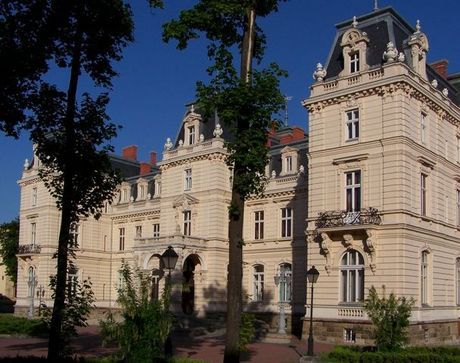Potocki Palace
The Palace of Counts Potockis is a majestic edifice in French Neorenaissance style of late 19th century.
The French architect Louis de Verny elaborated all of Beaux-Arts stylisic devices to produce a hypertrophied imitation of a French hôtel particulier. An open, parklike setting was scored to give the mansion a sense of depth. At the turn of the century the parkland gave way to a network of apartment buildings. The palace itself was adapted for holding wedding ceremonies in 1972 and subsequently underwent restoration.
The scale of this palace leaves little doubt as to the stature of the family that once owned it. The Potockis were amongst the most powerful clans in Central Europe. After Poland was wiped off the map in the eighteenth century they eventually rose up the ranks in the Habsburg hierarchy, providing several governors for Galicia itself. The last owner of the palace ended his days in exile in France in 1958. Recently restored, the palace now houses a branch of the Lviv Gallery of Art. The main focus is on Renaissance and Baroque art, and the interiors themselves are interesting.
Behind the fence with ornamental metal gate we see a majestic yet refined structure. The imposing palace is decorated with reliefs, mouldings, murals and stained-glass windows. The Palace of Potockis is a bright example of mature historicism architecture and one of the most interesting architectural landmarks of Lviv. It was designed by French architect Louis d’Overnu at the order of governor of Halychyna and Lodomeria Count Alfred II Joseph Potocki (1817-1889). The construction lasted from 1888 to 1890 under the supervision of Lviv architect Julian Tsybulski who also introduced some minor changes.
The style of King Louis XVI is predominant in the interiors of the palace’s first floor. The halls (the Red Hall, the Mirror Hall, the Blue Hall, and the Ordinat’s Office) are decorated with artificial marble, gilding, mouldings, and mirrors. Fireplaces cut from marble are adorned with gilded bronze.
There is a chapel with the miracle-working icon of Virgin Mary of Lviv (15th century) on the first floor. The second floor is occupied by the exposition of Lviv Art Gallery, opened by Ancient Arts Hall. European art of 14th-18th centuries is represented by the best works from the Gallery’s collection: a 15th-century Ukrainian icon of St. Paraskeva, paintings by M. Basaiti, J. Zucchi, S. Ricci, J.-E. Lyotard, J. Guerin, and F. Goya. The palace often hosts conferences, presentations, chamber concerts, and political meetings.
In the 2000s the President of Ukraine appropriated the palace as one of his residences. Some of its architectural motifs were borrowed by the next-door exhibition hall (inaugurated in 1996).
Potocki Palace is one of the symbols of Lvov history and architecture. Man can visit the palace getting there by flight to Lviv or flight to Kiev and after that – with a taxi or bus.




